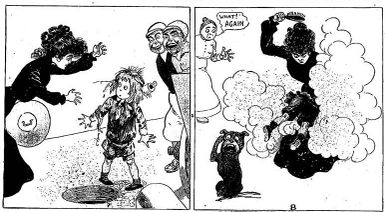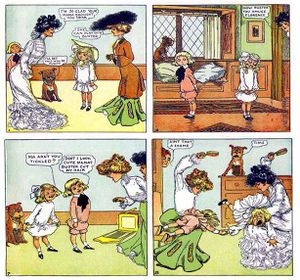Spanking in comics 1896-1918
Although narrative strips and single panel cartoons had existed in various forms since (at least) the 1830s, the modern comic strip only gained a foothold in American newspapers around the end of the nineteenth century. Urban myth credits Richard F. Outcault's Hogan's Alley as the very first American news strip, although as Don Markstein points out in his hypertext encyclopedia, Outcault's position as originator of the artform is debatable at best. Be that as it may, Hogan's Alley serves as a perfect example of early experimentation in the emerging medium. Most newspaper strips of the period were aimed at a wide demographic, making them accessible to readers of all ages and backgrounds. This would play a crucial role in determining appropriate content during this developmental stage.
Following Outcault's example, many early comic strips featured children cast in comical situations. Domestic humor and slapstick comedy naturally dominated the form, allowing cartoonists to depict the more amusing aspects of family life. Seen from this perspective, it was almost a foregone conclusion that spanking would make an early entrance, particularly since domestic corporal punishment was practiced on an almost universal basis at the time. Considered a 'normal' part of both child rearing and education, spanking would figure prominently in sequential art over the next six decades.
The Katzenjammer Kids
The first important newspaper strip to feature regular spanking imagery was Rudolph Dirks' The Katzenjammer Kids (King Features, 1897). Documenting the misadventures of an eternally bickering Germanic family, Dirks' storylines set the title characters, Hans and Fritz, against various beleaguered adults incapable of curbing their wilful misconduct. The main victim of their youthful exuberance was 'The Captain'; a cantankerous old seaman whose main purpose seemed to be falling prey to the boys' devious shenanigans. While Hans and Fritz often got away scott free (their Mama rarely believed they were capable of such perfidy), their behavior would occasionally result in a whipping over the Captain's knee - usually serving as the 'punchline' in the final panel.
This pattern of long-suffering frustration, petty misconduct and climactic punishment would become the template for the numerous comic strips that followed in the Katzenjammers' wake. With only minor variations, this basic scenario would be repeated across a range of titles, genres and characters. In some instances, spanking was employed as an integral component of the storyline, as was the case with Richard Outcault's Buster Brown (New York Herald, 1902).
Buster Brown

Outcault’s approach to Buster Brown was largely formulaic, pitting a mischievous (and rather effeminate) little boy against his aristocratic mother in an interminable battle of wits. Somewhat in parody of the strict moral codes of the early 1900s, Buster’s misconduct was invariably discovered, resulting in swift justice and a formal apology at the end of every episode. The content varied from the Katzenjammer strip in that the focus was shifted away from simple misbehavior (Hans and Fritz weren’t always caught out) to crime and punishment (Buster usually was).
From a structural viewpoint, Buster Brown could be described as a prototypical spanking strip, in that the natural consequence of Buster’s misdemeanors was a spanking (either implied or demonstrated) or some similar juvenile penalty. Subsequently, the punitive element was both integral and fundamental to the storyline. This was an important departure from the original Katzenjammer formula, in that the retributive component was a foregone conclusion. As with modern-day spanking fiction, the reader approached the Buster Brown series with the understanding that the main protagonist would undergo some form of punishment.
Another significant difference between the two strips was that Buster hailed from an affluent, privileged household, whereas The Captain and the Kids were represented as impoverished, uneducated foreigners. A comparative reading of the subtexts might suggest that American children were subject to tighter discipline than immigrants and therefore better behaved – a commonly held belief at the time.
The Outcault strip tended to challenge this view: in spite of his frequent maternal thrashings, Buster’s antics were often as wayward and anti-social as the Katzenjammer boys.' Both strips were given to mocking authority and both flouted contemporary notions of what constituted acceptable behavior in children. In addition, Buster was a most spectacular liar, as demonstrated by his blatantly insincere ‘resolutions’ at the conclusion of each story. Despite Buster’s superficial remorse, the reader understood that the boy had learnt nothing from his latest painful experience and would be back for more the following week. In short, Buster was every bit as irascible and duplicitous as Hans and Fritz, reinforcing the old axiom that ‘boys will be boys’ regardless of class or ethnicity.
Stereotypes
By contrast, the spanking of young female characters was much rarer during this period (though not unknown; see below), for the simple reason that there were virtually no comic strips featuring little girls in starring roles. With a few notable exceptions - such as Windsor McCay’s The Story of Hungry Henrietta (New York Herald, 1905) or R.M. Brinkerhoff’s Little Mary Mixup (New York World, 1917) - the early comics landscape was a male-dominated terrain in which women and girls generally provided token support. In line with popular gender stereotypes of the era, young boys were usually represented as high-spirited youths in the order of Tom Sawyer or Huckleberry Finn. As with Twain’s scallywag heroes, characters ranging from James Swinnerton’s Little Jimmy (1904) to Gene Byrne’s Reg’lar Fellers (1917) constantly found themselves facing the wrath of irate authority figures; most often parents, though it was not uncommon for teachers, police or even the occasional bystander to administer discipline. Most of the pre-war strips followed the Katzenjammer model, stressing adult frustration, youthful indiscretion and intermittent punishment.
Cinematic Influences
As the new medium continued to evolve, artists and illustrators began testing the limits of the artform, dabbling in fantasy and adult themes, and appropriating visual techniques from a wide range of external sources. The movie industry in particular would prove a major influence on the comic strip, especially after the release of Edwin S. Porter's The Great Train Robbery in 1903. It is worth noting that spanking was a common feature of early American cinema; D. W. Griffith employed minor corporal imagery in Birth of a Nation (1915), a film known to have had a profound effect on most other forms of visual media. As spanking became a regular plot device in motion pictures, the comic strip (and its cinematic equivalent, the animated cartoon) began to follow suit.
Interim: 1918
Prior to America’s entry into the War, comic strip spanking had been confined mainly to comedy relief in child-oriented funny-papers: with only a few notable exceptions, preadolescent boys had occupied the central position within the “spanking narrative," which was depicted in largely asexual terms. All of this had changed by the year 1918.
With the end of the War, the comics medium had undergone a subtle transformation. While still perceived as ‘trivial’ entertainment rather than fine art, the American public (along with the Government, the Military and the Business Sector) had seen the comic strip’s potential for advertising, propaganda and the dissemination of information. Adult themes and ideas began to creep into the form and content; cartoonists began experimenting with modernist concepts, mature subjects and – most importantly - female protagonists.
Little Girls
As mentioned above, the representation of young females as active protagonists was quite rare prior to World War One, although the inclusion of young girls as supporting characters had become standard practice by 1906. Many of the visual conventions associated with cartoon girls were pioneered by Richard F. Outcault in The Yellow Kid and more fully defined in Buster Brown. Buster’s sister Mary Jane became a regular co-star in the series, and provided a template on which many later female characters were based.
Again, following the accepted gender stereotypes of the time, Outcault’s girls were icons of Victorian innocence; pretty, petite, and amusingly shy. Paradoxically, they were also quite precocious for their time; Outcault sometimes drew them kissing Buster on the lips and even undressing before him. While extremely tame by today’s standards, such scenes were highly unusual for Pre-War representations, which stressed purity in all females, particularly children. The implied sexual element was most probably lost in the humorous content of the narrative, making it acceptable to audiences of the time.
Outcault may also have been the very first cartoonist to pen a F/G spanking scene; the opportunity being provided by Buster’s incorrigible habit of landing his friends in trouble. When blond-tressed playmate Florence is left in his care, Buster decides to shear off her golden locks and dress her up as a boy (and himself as a girl) – a relatively serious prank by Edwardian standards – resulting in a maternal discipline for both. Significantly, Florence is shown as the victim of Buster’s devilish streak, reinforcing the notion that little girls are essentially blameless by nature, but easily led astray by reason of their ‘innate’ naivety. Echoes of this attitude would persist in the comics medium until the mid-1970s.
Richard Outcault’s visual model – which was probably derived from late Nineteenth Century toiletry advertisements – was employed by various artists until the end of the war, at which time a more modernist approach was taken to the depiction of girls and women. Throughout the twenties, females would began to play an increasingly important role in the comics medium.
Chat rooms • What links here • Copyright info • Contact information • Category:Root
